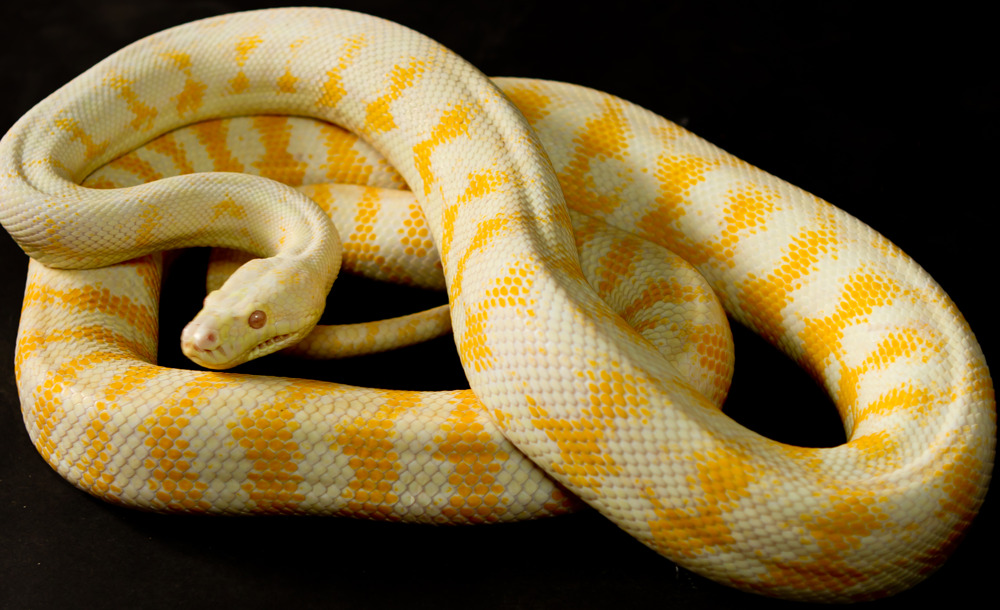During this year I have participated in discussion on forum about albinism and the possible feeding problems. I have done some research and I would like to share some exciting and at some point worrying knowledge.
First of all I love albino Darwin carpet python ohh yes! This is must have for me and I do like albino animals.
From:
But what is an albinism?
It is a genetic mutation that influence synthesis of melanin. All animals with this mutation have reduced or complete ceased production of melanin pigmentation. Various organs can be touched by albinism such as skin, eyes, hair follicles and scales.
But let's start from where snakes have colors. There are two possibilities: skin pigments or structural coloration. However in snakes pigments are main source of colors where structural coloration is popular in bugs and beetles.
- xanthophores (yellow): contain yellow pigments in the forms of carotenoids
- erythrophores (red): contain reddish pigments such as carotenoids and pteridine
- melanophores (black/brown): contain black and brown pigments such as the melanins
- cyanophores (blue): limited taxonomic range but found in some fish and amphibians.
Photophobia and decreased visual acuity due to light scattering within the eye (ocular straylight).
Reduced visual acuity due to foveal hypoplasia and possibly light-induced retinal damage.
Nystagmus, irregular rapid movement of the eyes back and forth, or in circular motion.
Amblyopia, decrease in acuity of one or both eyes due to poor transmission to the brain, often due to other conditions such as strabismus.
Optic nerve hypoplasia, underdevelopment of the optic nerve.
Science used to divide this mutation on two types but recent research indicate that one is currently valid. Oculocutaneus albinism (OCA) that influence melanogenic system of integument and eye.
Not all white animals are albinos but the main trait of all albino animals have pink or red eyes (because the veins are visible trough colorless retina).
So what are those pigments? Those colors are created by pigmentation cells in skin called chromatophores that are classed in few different groups.
Chromatophores cells, some of them without melanin pigmentation (transparent ones).
From: "Separation of Pigmented and Albino Melanocytes and
the Concomitant Evaluation of Endogenous Peroxide
Content Using Flow Cytometry" by Raymond E. Boissy, Linda S. Trinkle, and James J. Nordlund
I can tell you that all blue colors and blueish tonnes are not from cyanophores but from combination of other chromatophores.
The only structural colors of snakes are coming from iridiophores that giving snakes this beautiful rainbow reflection on skin. Main reflecting compound in those cells are crystals of guanine thus those cells are sometimes called guanophores.
The albinism is complex mutation and for example in mouse mutation of around 100 genes can cause lack of melanin and it is recessive mutation, that means that both parents need to have "albino" gene.
Albinism is caused mainly by lack of melanin pigmentation that is crucial for surviving of animals in the wild. Not only from obvious reasons like problems with camouflage but from various other physiological problems. One of them are problems with eyesight that can include iris, retina, eye muscles, and optic nerves. Absence of melanin are resulting in abnormal development of those structures causing blurred vision, focusing problems and general movement perception problems. Albino vertebrates exposed to intense light typically lose photoreceptors due to apoptosis which could lead to total loos of eyesight. In mammals for example retina cells are under developed and there is much less rod cells. However albino birds have much less eye vision problems than mammals. The American alligator "Claude" is partially blind because of lack of melanin in the eye. So it is hard to assume how snake vision is and if is impaired by albinism
In fish species albino genes are greatly reducing number of offspring's and not many of them will reach adulthood. In some albino mammals lack of melanin is linked to hearing problems.
Examples of eyesight problems in albinotic humans:
But lets come back to snakes! A lot of albino snakes are still having xantophores and erythrophores even when melanophores are not functional. So that is why sometimes you can buy high red albino snakes or for example like my beloved Darwin albino carpet python have nice bright yellow pattern.
I have heard an information about food striking problems of albino snakes but I tell you that most of snakes are not really using vision to locate prey and even when we still don't know much about albino health problems in reptiles exists but it could be wise to reduce light strength and UV intensiveness in albino enclosures but as long as they are in captivity and receive good care they will be great animals that will not cause more problems than any other normal snake.
https://blogger.googleusercontent.com/img/b/R29vZ2xl/AVvXsEgX6cyanrrTdZgXKqpGftid0DkOwxrE1RBbuej4RXq7XWWzZDx_vbCEQ67XX69SCaRLb6YjaI7kCnSn2GhLtbKILpCAXl9XnX8vjvgWerEJNmKp-dNGADUs9erY3YTpg0d5TX18Ew1zvYM/s1600/steve+irwin+albino+python.jpg












